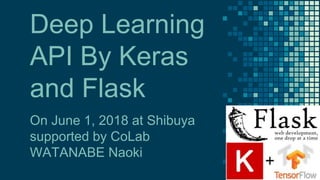Lecuture on Deep Learning API
- 1. Deep Learning API By Keras and Flask On June 1, 2018 at Shibuya supported by CoLab WATANABE Naoki
- 2. ūį╝║ĮBĮķ 2
- 3. Č╔▀ģų▒śõ 2017- ź╣ź┐®`ź╚źóź├źūäōśIż╩ż╔ 2016-2017 IBMżŪ蹊┐ķ_░k 2010-2016 ¢|┤¾żŪCERNż╬╦ž┴Żūėīg“Yķ_░k Ī± ź╣źŁźÕ®`źąż╬źķźżź╗ź¾ź╣ź█źļź└®` Ī± źĘź╔ź╦®`ź▐źķźĮź¾2017═Ļū▀ Ī± Ė╗╩┐Ž┬╔Į90Ęų Ī± 40ęį╔Žż╬╣·ż“įLå¢ Ī± 400+āįż╬šiĢ° (2017) Ī± ūį╚╗šZ覿╬├ŃÅŖż¼╚ż╬Č ColabżŪżŽtinderūįäė▓┘ū„ż╦ż─żżżŲż╬LTĮU“YżóżĻĪŻ 3
- 4. ─┐┤╬ 1. API 1. APIż¼║╬ż½ż“ų¬żļ 2. FlaskżŪ╗ŁŽ±źóź├źūźĒ®`ź└®`ż“ū„żļ 2. Deep Learning 1. Deep Learningż¼║╬ż½ż“ų¬żļ 2. VGGżŪ╗ŁŽ±šJūRż“ąąż” 3. Deep Learningż“╩╣ż├ż┐APIż“ū„żļ 4
- 5. pipźżź¾ź╣ź╚®`źļż“Ū░╠ßż╚ż╣żļżŌż╬ Ī± Flask Ī± Tensorflow Ī± Keras Ī± PIllow *Python 3.6.1 5
- 7. 1.APIż“└ĒĮŌżĘżŲ FlaskżŪīgū░ż╣żļWhat is API and How to make it?
- 12. ż’ż║ż½7ąąż╬app.pyż“Ģ°żŁpython app.pyżŪīgąą from flask import Flask app = Flask(__name__) @app.route('/') def hello_world(): return 'Hello, World!' if __name__ == '__main__': app.run() 12 URL html contents start server
- 13. Go to http://localhost:5000, and see 13
- 15. 15 from flask import Flask app = Flask(__name__) @app.route('/') def index(): return 'Index Page' @app.route('/hello') def hello(): return 'Hello, World' @app.route('/users/<username>') def show_user_profile(username): # show the user profile for that user return 'User %s' % username if __name__ == '__main__': app.run()
- 16. 16
- 17. 17
- 18. 18
- 20. 20 from flask import Flask, jsonify app = Flask(__name__) @app.route('/users') @app.route('/users/<int:id>') def users(id=None): print(id) users = [ {'id': 1, 'name': 'Alice'}, {'id': 2, 'name': 'Bob'}, {'id': 3, 'name': 'Charlie'}] if id is None: return jsonify(users) elif isinstance(id, int) and 1 <= id <= 3: return jsonify({'id': id, 'name': users[id-1]['name']}) else: return jsonify({}) if __name__ == '__main__': app.run()
- 21. 21
- 22. 22
- 23. 23
- 25. 25
- 26. 26
- 27. 27
- 28. 28
- 29. 2. Deep learningż╬ Ė┼─Ņż“└ĒĮŌż╣żļĪŻ Kerasż“╩╣ż”ĪŻ How deep learning works and how to use it
- 31. 31
- 36. 36
- 37. ╚½ĮY║Žīė 37
- 40. źŪźŻ®`źūźķ®`ź╦ź¾ź░ż╦żŽč¦┴Ģż¼▒žę¬ 1. źŪ®`ź┐ż╬ė├ęŌ 2. ź═ź├ź╚ź’®`ź»ż╬č¦┴Ģ 3. ź═ź├ź╚ź’®`ź»ż╬Š½Č╚ż“┤_šJ 40
- 41. Ī± GoogLeNet Ī± Xception Ī± ResNet50 Ī± InceptionV3 Ī± VGG16 Ī± VGG19 ż╩ż╔ĪŻ ż┐ż└żĘĪóč¦┴Ģ£gż▀ż╬ź═ź├ź╚ź’®`ź»ż¼╣½ķ_żĄżņżŲżżżļ 41
- 42. KerasżŪżŽę╗▓┐ż╬č¦┴Ģ£gż▀źŌźŪźļż¼║åģgż╦└¹ė├┐╔─▄ from keras.applications.xception import Xception from keras.applications.vgg16 import VGG16 from keras.applications.vgg19 import VGG19 from keras.applications.resnet50 import ResNet50 from keras.applications.inception_v3 import InceptionV3 model = VGG16(weights='imagenet', include_top=True) 42
- 43. VGG16 Ī± ImageNet Large Scale Visual Recognition Challengeż¼│§│÷ (2014) Ī± 13īėż╬«Æż▀▐zż▀īė Ī± 3īėż╬źšźļĮY║Žīė Ī± 1000ĘNŅÉż╬╗ŁŽ±ż“šJūR Ī± ų¬żķżņż┐źŌźŪźļż╬╗∙ĄAż╦VGG16ż¼╩╣ż’żņżŲżżżļ(ą┤šµ: keras document)ĪŻ 43
- 46. ż▐ż║ĪóVGGźŌźŪźļż╬Ė┼ꬿ“▒Ē╩Š(vgg_sample.py) from keras.applications.vgg16 import VGG16 model = VGG16(weights='imagenet', include_top=True) print(model.summary()) 46
- 47. 47
- 48. ╗ŁŽ±ż“šJūR (vgg_sample.py) from keras.applications.vgg16 import VGG16, preprocess_input, decode_predictions from keras.preprocessing import image import numpy as np img_path = 'cat.jpg' model = VGG16(weights='imagenet', include_top=True) img = image.load_img(img_path, target_size=(224, 224)) x = image.img_to_array(img) x = np.expand_dims(x, axis=0) x = preprocess_input(x) pred = model.predict(x) label = decode_predictions(pred) print(label) 48
- 49. Result (š²ĮŌŻĪ) Ī± Tiger cat (42%) Ī± Egyptian cat (36%) Ī± Tabby (12%) Ī± Lynx (2%) │÷┴”ĮY╣¹żŽĪó(imagenetID, źķź┘źļ, ┤_┬╩)ż╬źĻź╣ź╚ĪŻ 49
- 52. import os from flask import Flask, request, redirect, url_for, jsonify, Response from werkzeug.utils import secure_filename from keras.applications.vgg16 import VGG16, preprocess_input, decode_predictions from keras.preprocessing import image import numpy as np from PIL import Image import io źŌźĖźÕ®`źļż╬importż╚źŌźŪźļż╬šiż▀▐zż▀ż“śŗ║BĪŻ 52
- 53. appż╬ą¹čįż╚źŌźŪźļż╬šiż▀▐zż▀ż“śŗ║BĪŻ 53 app = Flask(__name__) model = None def load_model(): global model model = VGG16(weights='imagenet', include_top=True)
- 54. ╗ŁŽ±ż“šJūRż╣żļ @app.route('/', methods=['GET', 'POST']) def upload_file(): response = {'success': False} if request.method == 'POST': if request.files.get('file'): img_requested = request.files['file'].read() img = Image.open(io.BytesIO(img_requested)) if img.mode != 'RGB': img = img.convert('RGB') img = img.resize((224, 224)) img = image.img_to_array(img) img = np.expand_dims(img, axis=0) inputs = preprocess_input(img) preds = model.predict(inputs) results = decode_predictions(preds) 54
- 55. VGGż╬│÷┴”ĮY╣¹ż“jsonż╬ą╬ż╦š¹ą╬ż╣żļ response['predictions'] = [] for (imagenetID, label, prob) in results[0]: row = {'label': label, 'probability': float(prob)} response['predictions'].append(row) response['success'] = True return jsonify(response) 55
- 56. ź¬źūźĘźńź¾żŪĪó╗ŁŽ±ż╬źóź├źūźĒ®`ź╔╗Ł├µ return ''' <!doctype html> <title>Upload new File</title> <h1>Upload new File</h1> <form method=post enctype=multipart/form-data> <p><input type=file name=file> <input type=submit value=Upload> </form> ''' 56
- 57. źŌźŪźļż“šiż▀▐zż▀ĪóźóźūźĻź▒®`źĘźńź¾ż“īgąą (load_modelż└ż▒żŪmodelż“šiż▀▐zżÓżĶż”ż╦żĘżŲżżżļ) if __name__ == '__main__': load_model() # About threaded=False: https://github.com/keras- team/keras/issues/2397#issuecomment-377914683 # avoid model.predict runs before model initiated app.run(threaded=False) 57
- 61. 61
- 62. ▓╬┐╝╬─Žū Flask Quickstart http://flask.pocoo.org/docs/1.0/quickstart/ Building a simple Keras + deep learning REST API https://blog.keras.io/building-a-simple-keras-deep-learning-rest-api.html Imagenet 1000 classes and labels https://gist.github.com/aaronpolhamus/964a4411c0906315deb9f4a3723aac57 62
- 63. ThatĪ»s all, folks. Thank you. 63










![10
APIż╬Š▀╠Õ└²2/2: Ó]▒ŃĘ¼║┼](https://image.slidesharecdn.com/hldbed1lszmjyhlv642z-signature-afde9ee73ab19e9680d3be8ebf9bc3643442a7b0a892aaeb7b7469b51272a252-poli-180605072802/85/Lecuture-on-Deep-Learning-API-10-320.jpg)









![20
from flask import Flask, jsonify
app = Flask(__name__)
@app.route('/users')
@app.route('/users/<int:id>')
def users(id=None):
print(id)
users = [
{'id': 1, 'name': 'Alice'},
{'id': 2, 'name': 'Bob'},
{'id': 3, 'name': 'Charlie'}]
if id is None:
return jsonify(users)
elif isinstance(id, int) and 1 <= id <= 3:
return jsonify({'id': id, 'name': users[id-1]['name']})
else:
return jsonify({})
if __name__ == '__main__':
app.run()](https://image.slidesharecdn.com/hldbed1lszmjyhlv642z-signature-afde9ee73ab19e9680d3be8ebf9bc3643442a7b0a892aaeb7b7469b51272a252-poli-180605072802/85/Lecuture-on-Deep-Learning-API-20-320.jpg)






























![Response
{
"success":true,
"predictions":[
{
"label":"animal",
"probability":0.7
},
{
"label":"human",
"probability":0.2
},
{
"label":"fish",
"probability":0.1
}
]
}
ż│żņż½żķū„żļVGG API Requestż╚Responseż╬Č©┴x
Request
{"file":"binary image data"}
51](https://image.slidesharecdn.com/hldbed1lszmjyhlv642z-signature-afde9ee73ab19e9680d3be8ebf9bc3643442a7b0a892aaeb7b7469b51272a252-poli-180605072802/85/Lecuture-on-Deep-Learning-API-51-320.jpg)


![╗ŁŽ±ż“šJūRż╣żļ
@app.route('/', methods=['GET', 'POST'])
def upload_file():
response = {'success': False}
if request.method == 'POST':
if request.files.get('file'):
img_requested = request.files['file'].read()
img = Image.open(io.BytesIO(img_requested))
if img.mode != 'RGB':
img = img.convert('RGB')
img = img.resize((224, 224))
img = image.img_to_array(img)
img = np.expand_dims(img, axis=0)
inputs = preprocess_input(img)
preds = model.predict(inputs)
results = decode_predictions(preds) 54](https://image.slidesharecdn.com/hldbed1lszmjyhlv642z-signature-afde9ee73ab19e9680d3be8ebf9bc3643442a7b0a892aaeb7b7469b51272a252-poli-180605072802/85/Lecuture-on-Deep-Learning-API-54-320.jpg)
![VGGż╬│÷┴”ĮY╣¹ż“jsonż╬ą╬ż╦š¹ą╬ż╣żļ
response['predictions'] = []
for (imagenetID, label, prob) in results[0]:
row = {'label': label, 'probability': float(prob)}
response['predictions'].append(row)
response['success'] = True
return jsonify(response)
55](https://image.slidesharecdn.com/hldbed1lszmjyhlv642z-signature-afde9ee73ab19e9680d3be8ebf9bc3643442a7b0a892aaeb7b7469b51272a252-poli-180605072802/85/Lecuture-on-Deep-Learning-API-55-320.jpg)







